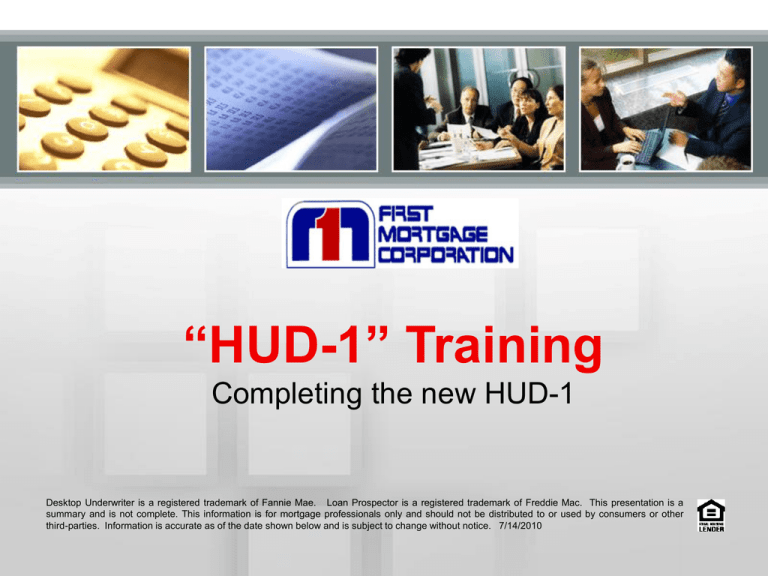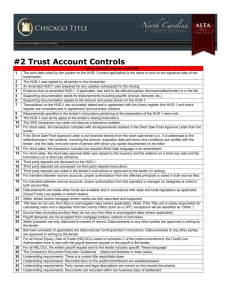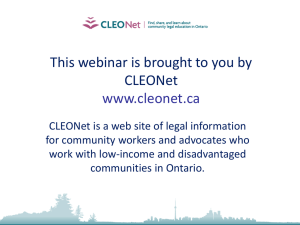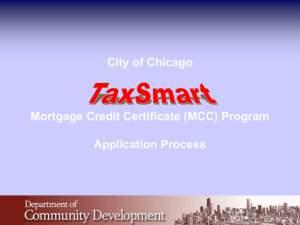Completing the new HUD-1 - First Mortgage Corporation
advertisement

“HUD-1” Training Completing the new HUD-1 Desktop Underwriter is a registered trademark of Fannie Mae. Loan Prospector is a registered trademark of Freddie Mac. This presentation is a summary and is not complete. This information is for mortgage professionals only and should not be distributed to or used by consumers or other third-parties. Information is accurate as of the date shown below and is subject to change without notice. 7/14/2010 Topics of Discussion • Introduction / Purpose of the HUD-1 • Completing the New HUD-1 Settlement Statement • Trainings and Support FIRST MORTGAGE Introduction / Purpose • The HUD-1 Settlement Statement is required under Section 4 of the RESPA and 24 CFR part 3500 (Regulation X). • This form is to be used as a statement of actual charges and adjustments paid by the borrower and the seller – to be given to the parties in connection with the settlement. • The HUD-1 is prepared by the settlement agent to itemize all charged imposed upon the Borrower and the Seller by the loan originator and all sales commissions, whether to be paid at settlement or outside of settlement, and any other charges which either the Borrower or the Seller will pay at settlement. FIRST MORTGAGE HUD-1 Completing the “new’ HUD-1 Settlement Statement HUD-1 Page 1 Identifications First Mortgage Corporation Henny Doe HUD-1 Page 1 The Transaction • • • • The 100 and 400 subsections of Part J and K have not changed. Closing agents may still offer separate settlement statements to the buyer and seller showing only their part of the transaction. Technical and inadvertent errors, and tolerance violations, may be corrected, and a revised HUD settlement statement be provided within 30 days of closing. 104 & 105: These lines are for additional items owed by the borrower that are not on the GFE and items paid by the seller prior to settlement and being reimbursed to the seller from the borrower at settlement. HUD-1, Page 1 Credits and Debits • • • • Seller credits (also called seller concessions or seller contributions) go on lines 204-209, and 506-509 as a credit to the borrower and a payment to the seller. Deposits held by the broker are shown as payments to the broker on line 501, instead of being included as part of the broker commission on page 2. Second mortgage loan net disbursements must be shown on lines 204-209 (the lender is named and the loan amount is shown in parentheses). 200 Series: If the Seller is paying any of the buyers closing costs, the charges must show on page 2 as a charge to the buyer, with an offsetting credit here from the sellers. HUD-1, Page 1 Credits and Debits cont’d… • • • Borrower POC payments (eg., application fees) are shown on lines 204209 as credits. Real Estate broker credits must name the individual giving the credit (not the company). HUD did not provide any guidance on how to determine who contributes this credit, or whether the name of the broker, the salesperson, or the clerk writing the check is on the HUD-1. This also conflicts with state law. 500 Series: The owner’s title insurance must show as a charge to the borrower on page 2 of the HUD with a credit back from the seller here (as long as the seller’s paying for it). HUD-1, Page 1 Adjustments • Lines 210 to 303 and 510 to 603 have not changed. HUD-1, Page 2 Broker Commissions • • • Only the portion of the commission net of the earnest money deposit is shown on page 2 in the 700 series. Percentages used to calculate commissions are no longer disclosed. 701 - 703: The commission box no longer has percentages, instead it indicates actual fees. The total amount of commission to each real estate broker or agent must be shown on lines 701 and 702. The amount of the commissions disbursed at settlement must be shown on line 703. HUD-1, Page 2 Origination Fees • • • • • The “origination charge” is a lump sum adding lender and broker fees. Add “” “” to designate that the origination fee may be deductible for income tax purposes. The YSP and any other lender credits are shown as a negative number on Line 802. In a no fee loan, the lender makes up phantom origination and discount fees for Line 801, and issues an equal credit on Line 802. 801: This line is used to record “Our origination charge” and includes all charges received by a loan originator, except for any additional charge (“points”) for the interest rate chosen on the loan. The amount on line 801 also includes all amounts received for any service, including administrative and processing services, performed by or on behalf of the lender or any mortgage broker. 802: Use to record “Your credit or charge (points) for the specific interest rate chosen and must not be listed in either column or shown on page 1. HUD-1, Page 2 Origination Fees cont’d… • • • Only fees that are paid by the seller and never paid by the borrower are included in the seller’s column. Fees paid by the seller and broker at or before closing (pursuant to negotiations) for services required by the lender are shown as borrower paid fees, and a credit is given in the 200 series (seller paid fees are also shown in the 500 series). Credits for fees paid before closing are also shown on Page 1 of the HUD-1. Third party administration and processing fees are not shown as POC items. HUD-1, Page 2 Origination Fees cont’d… • Appraisals, credit reports, flood searches, tax service, surveys required by the lender, and governmental loan program charges, such as VA, FHA, Rural Housing Service, or state bond loan programs, are not “administration or processing” costs or origination fees, and are shown as separate borrower charges and not as part of the “origination fee” in the 800 series (don’t ask me why). • Services are shown in the 800 series if the borrower picks a provider identified by the lender, but in the 1300 series if the provider was not identified by the lender. Given that the lender must list the available providers, the lender violates RESPA if the borrower picks someone off the list. HUD-1, Page 2 Insurance and Escrow • • • • • The 900 and 1000 series have not changed, except HUD hard coded the Aggregate Adjustment on line 1007. The Aggregate Adjustment has not changed. MIP cannot increase from the GFE. All other charges in these sections are not subject to any limits on changes from amounts on the GFE. 1000 Series: The impound accounts now will roll up into one total with the breakdown shown outside the column. HUD-1, Page 2 Title Fees • • • • Line 1101 includes the lender’s title insurance premium, closing fee, wire and fax fees, title doc prep charges, title search fee, overnight delivery fee, notary fees, survey fees required by the title company, and other title and closing agent admin and processing fees. These fees are not separately itemized. Line 1101 includes room rental fees and other suspicious title agency charges. The closing fee, survey fee, lender’s title policy, and owner’s title premium are broken out as POC items. The portion of the premium retained by the title agency and underwriter are disclosed as POC items. HUD-1, Page 2 Title Fees cont’d… • • • • Survey fees are included in Line 1101 and placed on a line after 1108 as a POC item if the survey is required by the Title agency to issue the policy. Surveys required by the lender are disclosed in the 800 series, unless the borrower selected a surveyor that was not identified by the lender (in which case the survey goes in the 1300 series). Other third party fees, such as independent contractor notary fees and title plant fees, are shown as POC items on lines 1109 to 1112. Title fees are generally subject to the 10% tolerance. 1101: All of the Borrower’s title and escrow fees are now rolled up into line 1101 with the exception of the owner’s title insurance which is shown as a charge to the borrower on line 1103. HUD-1, Page 2 Title Fees cont’d… • 1103: Buyer will be charged for the owner’s policy to conform with Box #5 on the GFE, but if the contract calls for the seller to pay for the owners policy a credit/debit will be shown in the 200 series. Remember, some bank owned or FannieMae contracts will have the buyer purchasing the owners policy. • 1107: Reflects the title issuing agent’s portion of the title premiums & endorsements. • 1108: Reflects the title underwriter’s portion of title premiums & endorsements. HUD-1, Page 2 Government Charges • • • Line 1201 is the total of the government recording charges. Examples of such charges include but are not limited to: – State and local fees for recording the deed, mortgage, deed of trust, releases, and – Any other instrument recorded or document recorded to preserve marketable title or to perfect the lender’s security interest in the property. There is a 10% aggregate tolerance for recording fees and fees for services from providers identified or required by the lender or broker. The transfer taxes however, must be absolutely correct. HUD-1, Page 2 Borrower Selected Services • • • • These are services the borrower shops for, such as home inspections, that (i) the lender requires but does not dictate who can provide the service (and does not identify the provider chosen by the borrower), or (ii) the lender does not require. A list of all such services and the available providers must accompany the GFE. The fees for these services can change at any time without causing a violation. 1300 Series: Will be used for anything that was in Box #6 on the GFE. HUD-1, Page 2 Disclosing Points • • • • Includes Origination Points. Discount points that might be deductible are shown in the margin at the bottom of the 2nd page (where you would ordinarily put a signature block) on the bottom of the 2nd page of the HUD-1. Note that HUD-1 instructions say that Line 801 cannot include points. HUD contradicts itself in the FAQ. The amount on IRS Form 1098 is disclosed below Line 1400. HUD-1, Page 3 Origination Fees • • • • • Category 1: This section will compare the GFE to the HUD figures. Changes in Category 1 CAN NOT increase at closing. The 3rd page of the HUD-1 is all new. The Lender is responsible for providing all information needed by the closing agent to complete this page. Note that broker and lender fees cannot increase (they can decrease), and that the credit from the lender to the borrower cannot increase. HUD should have said this fee cannot change. The amount paid to the broker need not correspond to the amount in Line 802. Do not confuse Transfer Taxes with Recording Fees – the former cannot change from the amount disclosed in the GFE, and the latter is subject to an aggregate 10% tolerance. HUD-1, Page 3 10% Tolerance • • • • Category 2: Changes in Category 2 CAN NOT increase in total by more than 10% at closing. This section includes all of the fees disclosed in Section 3 of the GFE. Aggregating all of the fees and providing a 10% tolerance for the sum gives everyone a little breathing room – some fees can be higher or lower without causing a violation. Lenders may cram down one provider so the total fees are within tolerance. HUD-1, Page 3 10% Tolerance • What to remember (weird stuff): – Title insurance premium disclosures are subject to a tolerance, but hazard, earthquake and flood insurance premiums have no limit. – Fees paid by the seller, broker and the lender that are disclosed as borrower paid fees are subject to the 10% tolerance. – It makes sense for the broker or lender to disclose the highest fees on its list of providers in the GFE. HUD-1, Page 3 Insurance and Escrow • • • Category 3: Changes in Category 3 CAN increase or decrease at closing. These are fees that can change. These fees are from the 900, 1000 and the 1300 series. Note: Title fees cannot increase unless the borrower asks for additional coverage's (which is considered a changed circumstance). HUD-1, Page 3 Loan Terms • Loan Terms: Loan Terms are disclosed to consumers in a simplified format in this section. • Loan terms at the bottom of page 3 must be provided by the lender (do not try this at home) HUD-1, Page 3 Loan Terms cont’d… • FHA no longer have a “prepayment penalty” in the eyes of RESPA and TILA. Tips… • If a seller pays for a charge that was included on the GFE, – – – • If a loan originator (other than for no-cost loans), real estate agent, other settlement service provider, or other person pays for a charge that was included on the GFE, – – • The charge should be listed in the borrower’s column on Page 2 of the HUD-1. That charge should also be offset by listing a credit in that amount to the borrower on lines 204-209 on page 1 of the HUD-1, … and by a charge to the seller in lines 506-509 on page 1 of the HUD-1 The charge should be listed in the borrower’s column on page 2 of the HUD-1. … with an offsetting credit reported on page 1 of the HUD-1, identifying the party paying the charge. Charges paid outside of settlement by the borrower, seller, loan originator, real estate agent, or any other person, must be included on the HUD-1 but marked “P.O.C.” for “Paid Outside of Closing” (settlement) and must not be included in computing totals. – However, indirect payments from a lender to a mortgage broker may not be disclosed as POC and must be included as a credit on Line 802. HUD-1 Final Thoughts… • You can add an addendum page instead of placing information in the margin. • Tolerances for MDIA and RESPA are different issues and are calculated differently (and separately). • There are no penalties under RESPA for violations, but the State can fine parties for RESPA violations. • YOU HAVE NO OBLIGATION TO EXPLAIN THE GFE OR THE HUD-1 TO ANY BORROWER OR SELLER!!! – The Lender is the only party obligated to explain the loan terms and the settlement statement. New “HUD-1” IMPLEMENTATION DATE New HUD-1 will apply to all loans for which creditor receives an application on or after January 1, 2010 FMC Training & Support First Mortgage is committed to providing ongoing trainings on the new RESPA Reform 1. RESPA Overview Training / Completing the GFE DONE 2. Completing the HUD-1 Settlement Statement DONE 3. Point Training – You need Point Version 7.2 DONE 4. FirstBase Training – FMC internal LOS system DONE 5. FMC Process Training – DONE HUD is seeking legislation to determine how to assess penalties for noncompliance so BE PREPARED!!! Train your internal teams/staff on the new RESPA rules, GFE, and any new software requirements DOCUMENTATION is the key! FIRST MORTGAGE FIRST MORTGAGE On behalf of First Mortgage, thank you for joining today’s training and we hope the information provided will help you build your business!









